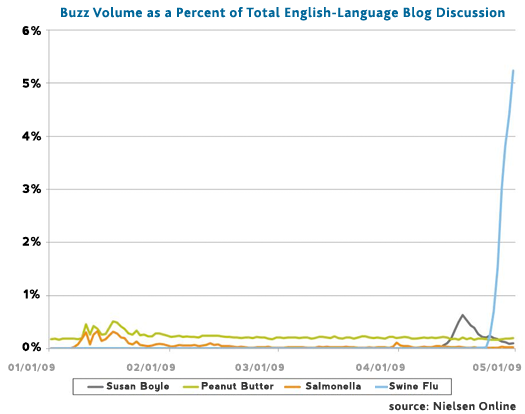Melissa Davies, Nielsen Online
It has been impossible to escape the news about swine flu (or H1N1 virus) this week. One of the most interesting developments this week has been watching the way people are using the Internet, and specifically social media, to connect with one another around this issue. As of yesterday, buzz volume about swine flu in the blogosphere was still on its meteoric climb, far surpassing discussion levels for the peanut butter/salmonella scare that happened earlier this year or, for a different reference point, recent pop singing sensation Susan Boyle.

One measure of the extent of Internet engagement regarding swine flu is Wikipedia. The site’s page on swine influenza has been updated literally hundreds of times this week. Wikipedia created a separate page focused on the 2009 swine flu outbreak for current information – that page has been updated 119 times as of early on May 1.
Swine flu is also gaining notice on the social networking site Facebook. On Monday there were around 100 Facebook groups dedicated to swine flu. As of early May 1, there are more than 500 groups. The three largest groups have a combined total of 10,000+ members.
Twitter has gained media attention this week as a source of fervent swine flu discussion. By some accounts, swine flu mentions topped out at a rate of more than 10,000 tweets per hour earlier in the week. There were concerns that this discussion created unnecessary fear about swine flu – it certainly can’t be denied that misinformation was being shared alongside good information about the epidemic. There have been plenty of joking references to swine flu, too, but a significant portion of the discussion seems to center around a legitimate desire to connect with others and talk about real issues. Consider these tweets from this morning:
- “Swine-flu symptoms: Checklist to see if you may be infected: … https://bit.ly/9L4Wx
- “This swine flu stuff is kinda creeping me out.”
- “Monitoring the travel/swine flu scenario/issues closely. Biden didn’t do the travel industry any favors yesterday!”
- “Thinks it’s lame that they had to come up with a “politically correct” name for swine flu, to compensate for the ignorance of the masses.”
- “New flu strain having significant indirect adverse impacts on our swine industry at a time when our producers absolutely do not need it!”
CDC Provides a Voice of Reason
Among all those bloggers and tweeters talking about swine flu was a voice that might be surprising to some: the government. The Centers for Disease Control (CDC) is leveraging several different online channels to provide a voice of reason in the fury of discussion around swine flu – and in the process is setting a roadmap for those wondering how social media can be used for crisis communication.
CDC has a few Twitter accounts, but two – @CDCemergency and @CDC_eHealth – are being used to updates about swine flu. CDCemergency’s tweets include links to more information and provide straightforward tips on avoiding swine flu, such as “New Guidance – Swine Flu – home isolation of the sick, school closures, and other social distancing interventions.” @CDC_eHealth is updating with slightly lower frequency, but provides the same type of straightforward, informational updates, including links and an 800 phone number for more information on swine flu, as well as a handwashing e-card that people can send to friends and family.
What is particularly amazing is the number of people who are being reached in this way: At this writing, CDCemergency has more than 65,000 followers. That number is up 86% since we began tracking it on Tuesday. Compare that to between 500 and 700 individuals who were following HHS Twitter updates when the salmonella/peanut butter crisis hit a few months back.
@CDC_eHealth is also tweeting links to CDC’s YouTube channel, which has several new videos related to swine flu, as well as a phone number and e-mail address for more information. One video that provides a basic overview of swine flu, including symptoms and prevention strategies, has racked up more than 198,000 views and has a 4.5-star rating based on 881 reviews.
CDC.gov: CDC has also set up a dedicated page about swine flu on its site, with a current count of confirmed cases in the U.S. by state, travel notices, guidance for professionals and tips on staying healthy. The site also offers subscription options for e-mail updates and RSS feeds, a podcast on symptoms, and a link to CDC’s Twitter profiles. All updates are available in English and Spanish. So far this week, the site has been updated eight or nine times daily, including on the weekend.
CDC’s online presence seems to be having an impact: Unique visitors to cdc.gov have increased by nearly 100 percent this week, while total visits have grown 123 percent.
Online discussion of swine flu continues to grow at an incredible pace, far surpassing the rate of new diagnoses. We’ll continue to watch the discussion unfold and measure new developments in the days ahead.


